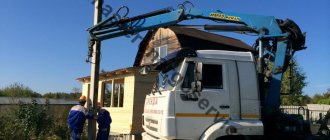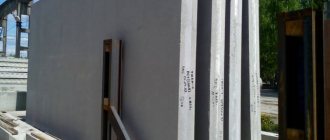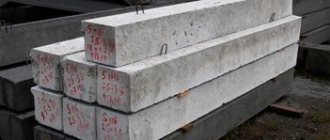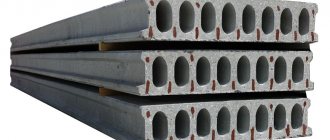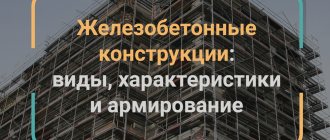Types of power line supports
According to the manufacturing technology of reinforced concrete products, supports can be of two types:
- Vibrated. A reinforcing frame is placed in the formwork, which is filled with concrete mortar. The mold is placed on a vibrating table, which vibrates to compact the concrete;
- Centrifuged. Here the equipment is the same, only the formwork is rotated about its axis until the concrete mixture hardens. This is how round support pillars are made.
Depending on the location of the poles in the power transmission system, there is another classification:
- Anchor. This is a standard electric pole without protrusions or mortgages. They are used more often as an intermediate element of the supporting structure of power lines;
- Angular. Location – line rotation;
- End These are two pillars: one vertical, the second inclined, serving as a support. Once installed, they form the letter “L”.
The types of power transmission line supports are not limited to this. There are other classifications where the characteristics of reinforced concrete products are taken as a basis. For example, the type of reinforcing frame, the density of the concrete used, the electrical conductivity of the support, etc.
All the above-mentioned supports are assembled from SV brand racks. The abbreviation means that this is “C” - stand, “B” - vibrating. The marking also contains numbers. For example, brand SV 95-2:
- 95 is an electric pole with a length of 9.5 m;
- 2 – bending moment.
The last characteristic is important because electric poles bend under the influence of wires, wind and ice.
Painting and care yourself
In order to give the strip of sections your own unique style and emphasize the design of the yard, you need to paint the concrete fence to suit your requirements. In addition, the structure itself, without painting, is poorly protected from weather influences. Over time, the material becomes dull in color and may completely deteriorate. Painting is a mandatory step in installing a fence. If you decide to save money and adjust the color yourself, you need to purchase:
- paint tray,
- roller with fur lining,
- flute brush,
- spray gun,
- glasses, gloves, work clothes.
Article on the topic: How to hold a corporate party in a sauna
Before re-painting, the fence must be carefully checked for fungus and defects and eliminated. Cover all cracks and chips. Before applying paint to concrete fence sections, be sure to prime the entire structure twice. This will not only allow you to apply paint more reliably, but also protect the material from wear. When choosing a primer, you need to give preference to a material based on the same substance as the paint.
After the primer is completely absorbed and dry, apply paint to all narrow patterns and hard-to-reach places using a brush. Then immediately go through with a roller. Take a drying break for about 24-32 hours. Then apply another layer of paint using a spray gun. This will make the surface smooth and uniform. When choosing a time for painting, you need to make sure that there will be no rain for the next two to three days.
In the modern world, reinforced concrete fencing has long won the trust of consumers. Low costs and long-term use make this material affordable and in demand. Concrete sections can be made independently, but in the case of a single installation of a fence on your site, this is unprofitable. The costs of materials, special devices and transportation will be significantly higher than ordering a ready-made fence from concrete sections. If you make a fence yourself, there is a high risk of making a low-quality or unaesthetic design. Who would want to take that risk? After all, a fence is the business card of the owner of the house.
How to install electricity poles
Rules for installing electric poles are based on the weight of the reinforced concrete product. Therefore, during the installation process they use special equipment:
- a crane for lifting the support and installing it in the prepared well;
- a tractor that brings the poles to the installation site.
There are two main technologies for installation in the ground:
- The electrical support is simply immersed in the ground. No additional elements are used for this;
- With installation on a base.
The second position is two different approaches to installation work. One option is to insert a stand into a prepared well, which is 20-30 cm larger than the cross-section of the reinforced concrete product. After the support is aligned vertically, its lower part inside the well is filled with concrete mortar. Installers often call this design either frame or frame.
The second option is installation on metal or reinforced concrete piles. That is, before installing an electric pole, a pile is driven into the ground on which it will rest.
But the installation process itself begins with the assembly of the support. That is, a traverse and a grounding descent are installed on it. After this, insulators are screwed onto the traverse. A stencil must be printed that provides information about when the electric pole was installed and the serial number of the element in the electrical system network.
All technologies necessarily involve the process of waterproofing part of the electrical network elements that are immersed in the ground. Hot bitumen is usually used for this. Depending on the type of soil and the mass of the reinforced concrete product, the supporting structure is immersed to a depth of 1.2-2.0 m.
If traditional installation technology is used, that is, not frame, then the gaps between the walls of the well and the pillar are filled with either excavated soil or fine or medium-sized crushed stone. The latter can be replaced with gravel. At the same time, the bedding is compacted well.
The installation of an end-type electricity pole is carried out in the same way, but first a vertical support is mounted, which is immediately fixed in the ground. And then the second inclined one. Both racks are connected to each other by clamps, cross ties or special crossbars. According to the technology, spacers or braces are temporarily installed.
Attention! Backfilling soil into the well gap or pouring concrete mortar can only be done after the installation height of the supporting structure has been checked. If the height is greater than required, the well is deepened. If less, it is covered with soil or crushed stone with thorough compaction.
Production
The creation of concrete pillars is carried out using the method of vibrocompression and centrifugation. Strengthening the strength of a concrete product is achieved through reinforcement, and resistance to cracks, frost and moisture is ensured by adding special components to the solution. In seismically active zones, preference is given to supports with thickened walls. Lighting fixtures are mounted on such stands.
Vibrocompression is used to produce the base for power lines with a voltage of 0.38-35 kV. Above 35 volts requires manufacturing by centrifugation.
The process of making a support includes creating reinforcement and installing it in the formwork.
The process of producing concrete pillars begins with the creation of a metal frame. It consists of steel rods, liners, contour spirals, loops and tubes. Next, the structure is attached to the formwork, filled with concrete, leveled and covered with thermal insulation. After which the product is subjected to isothermal treatment. The completion of the work is the dismantling of the formwork, cutting of the reinforcement and building up the ground loop rods.
Tools and materials
- Plywood or wooden boards with a thickness of at least 25 mm.
- Screwdriver and screws.
- Welding machine and consumables for it.
- Metal rods or other fittings.
- Roulette.
- Polyethylene film.
- Concrete mixture.
Formwork and frame
To begin constructing the formwork, you need to think through the shape of the pillar in advance, create a drawing and calculate the parameters of the future product. Based on the data obtained, formwork parts are cut out of plywood or wood. Then all parts, except the top, are securely fixed to each other, ensuring the tightest possible fit at the joints. Additional waterproofing will be provided by a polyethylene film used to cover the formwork.
To give strength to the product, a frame is constructed from steel rods, which are welded together.
The metal frame plays an important role in the concrete support. In addition to additional strength, it also adds stability to the structure. It is constructed from steel rods the entire length of the column and many short rods, fixed as jumpers between the load-bearing parts. All parts of the frame are welded together or securely twisted with wire.
Pouring a pillar
The reinforcement structure is placed in the formwork so that when pouring the metal is 3-4 cm from the concrete surface. The solution itself should be laid slowly and carefully, avoiding the formation of voids. The entry of air can be prevented if, when pouring, the solution is cut through with a trowel, and bubbles are removed using a vibrating screed. It is also important that the reinforcement is covered with mortar in all places. Otherwise, the metal will begin to rust. After pouring and compacting is completed, the formwork is closed with the last piece.
Advantages of reinforced concrete pillars
Power line supports made of reinforced concrete have:
- High strength. They can easily withstand not only strong wind loads, but also impacts from collisions with cars and other vehicles;
- One hundred percent environmentally friendly. There are no materials in the design that, under changing humidity and temperature or under the influence of the sun, release substances harmful to humans into the air;
- Service life – 100-150 years;
- Minimum financial and labor costs for repair work;
- Dielectric properties.
Electrical supports are an element of the architecture of cities, towns and transport interchanges. Not the most presentable appearance does not repel. It is clear that their main task is to create safe conditions for the transportation of electricity.
Concrete sectional fence: section sizes and installation
Content
- Design advantages
- What are the varieties and forms?
- What to look for when choosing a fence
- Fence installation and preparation
- Painting and care yourself
A fence made of concrete sections is an ideal option for modern fencing for the private sector. Such structures not only fulfill their intended purpose as a fence, but will also change the aesthetic appearance of any yard. A concrete sectional fence creates a psychological feeling of security and conveys the popular expression: “My home is my fortress.” Today there are many types of sections. The lineup offers options for even the most demanding owner. You can choose a fence to suit every taste, yard design and financial capabilities of the customer.
Sectional reinforced concrete fences
Reinforced concrete (reinforced concrete) sectional fences (see photo) are strong, reliable, monumental. Sometimes they are called concrete, which is incorrect, because... Reinforcement is placed in pillars and slabs to create strength.
Despite the apparent roughness and inexpressiveness, fences made of concrete slabs can be attractive (see photo). To create a single ensemble, slabs, pillars, and covering caps are made (see p. Additional elements: pillars, pillar caps, foundation caps). But the wicket or gate will have to be made of a different material. Reinforced concrete goes well with a wooden, welded, forged entrance group. You can order the production and installation of metal gates and wickets on eris.by.
Article on the topic: House landscaping, how many meters from the fence and from the roadway
The disadvantages of a fence made of reinforced concrete (reinforced concrete) slabs include the difficulty of transportation and installation: the weight of one concrete element is 30-70 kg.
The service life of the fence is up to 50 years.
The price of a reinforced concrete (reinforced sectional concrete) fence, the cost of its installation depends on the cost of work and the design of the fence: height, number of panels, type of posts, pigmentation of elements, presence of a foundation. Therefore, it is generally impossible to determine how much a concrete fence costs.
Production of reinforced concrete fence slabs
The production of reinforced concrete fence slabs in Belarus is regulated by STB 1236-2000 “Reinforced concrete fencing products. General technical conditions”, which stipulates the requirements for the mixture, fittings, quality, appearance of products, transportation, storage, and defines permissible deviations from the declared dimensions.
The technology for manufacturing composite elements of concrete fences is different:
- Vibratory casting method: install on a vibrating table, lubricate the mold → pour half of the molding sand → turn on the vibrating table (30 seconds) → install the fittings → turn on the vibrating table (30 seconds) → add the remaining mixture → turn on the vibrating table (30 seconds).
- Dry pressing: place on a vibrating table, lubricate the mold → fill in the molding mixture with a reduced water-cement ratio → turn on the vibrating table, place under the press until the mixture is completely compacted → move to drying. The products are more durable and frost-resistant than using the vibration casting method.
Molds for manufacturing, mass production of reinforced concrete (reinforced concrete) blocks, fence posts differ in material and number of turnover cycles: fiberglass (up to 15 thousand castings), polyvinyl plastic (up to 5 thousand castings), PVC plastic (30-50 castings).
Forms for concrete fences are distinguished:
- By type of manufactured products - span slabs, pillars, additional elements;
- To size;
- Texture (drawing).





